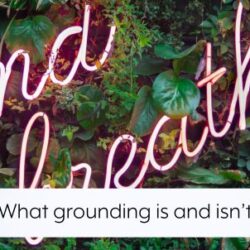
What is trauma?
Trauma is not just about having a bad day. Trauma is about being flooded and overwhelmed. It’s a threat, real or perceived, to our bodily integrity, and as I would put it, it’s life-threatening powerlessness. To understand trauma, we need to understand what goes on in the body at the moment of trauma and how the physical impacts of trauma are rooted in basic, primitive responses shared by many animals, including us as mammals and humans. This physical survival system is founded in our autonomic nervous system, which is geared towards responding to threat and promoting our survival. It’s different to the central nervous system, comprising the brain and spinal cord, which we mostly have voluntary control over. The autonomic nervous system is primarily unconscious – it’s what goes on without thinking, even when we’re sleeping, 24 hours a day: it keeps us breathing and digesting and pumping blood around our body.
This autonomic nervous system has traditionally been divided into two main branches: the sympathetic nervous system and the parasympathetic nervous system. These two branches tend to work in a complementary relationship to one another – they help to balance the body and keep its homeostasis. Generally speaking, the sympathetic nervous system ramps us up ready for action: it’s engaged in the fight and flight response. And the parasympathetic nervous system slows us down: it’s there to ‘rest and digest’ or ‘feed and breed’ as some people call it. So you could say that the sympathetic nervous system is like an accelerator, and the parasympathetic is like a brake. Throughout the day the body is constantly adjusting, accelerating and braking, placing us in a dominant state of either sympathetic or parasympathetic nervous system activation, in order to respond optimally to the demands of life we are facing at any given moment.
And what is the trauma traffic light?
Keeping the driving analogy, we could talk about this in terms of the ‘trauma traffic light’, or rather three physiological states that the body can shift gear between, depending on levels of threat or security in the world. First of all, there’s the green zone. The body enters this state when all is well with the world, when we perceive our environment to be safe. In this case, our body and brain automatically gear us up to be able to focus on people. It is what has been called the ‘social engagement system’. We can chat, we can play, we can work, we can feed, we can breed – we can do life! This is a state of predominant parasympathetic nervous system activation, and it’s a good thing: we’re chilled out and relaxed, we feel safe, and we can get on and explore and conquer life. But this is a state that many trauma survivors find it difficult to achieve consistently or for long periods of time.
Instead, many trauma survivors find themselves frequently triggered into the amber state of alert. The body and the brain perceive some kind of threat in the world: perhaps a near-miss on the motorway, an unexpected knock on the door in the middle of the night, the sounds of a disturbance with raised voices, the approach of a mugger or other assailant. The amber state can also be triggered by reminders of trauma from the past, or psychological threats, events we perceive to be life-threatening: losing our job, our partner getting sick, social rejection. When this happens, our body gears us up automatically to respond to this challenge – it mobilises us to do something to survive, and it engages the fight-or-flight responses of the sympathetic nervous system. There is a cascade of neuro-electrical and chemical responses in the body and the brain, and we enter a state of mobilisation – we’re ready for action.
But what if we can’t handle what comes our way? What if the threat is too great? What if we can’t escape from the assailant, or we don’t have the resources to survive? When we are overwhelmed, our body switches into red alert mode. It assumes that this is a critical, life-threatening event. And so it switches from the sympathetic nervous system back into the parasympathetic nervous system…which sounds a little confusing! After all, this isn’t a time to rest and digest or feed and breed, is it? No it’s not, and this paradox is explained by the presence of two distinct pathways in the parasympathetic nervous system. The red zone utilises the unmyelinated dorsal vagal circuit rather than the myelinated ventral vagal circuit used by the green zone.
In this red alert state, when the body perceives that it can’t do anything active to survive (fight or flight), the body goes into an immobilised state. Again, there is a cascade of chemical and neuro-electrical changes in the body, and we go into ‘freeze’ – complete shutdown. The dorsal vagus nerve is activated, our heartrate drops, and we enter a state of feigned death. This red alert response is designed to help us survive by fooling a predator into leaving us alone, and it comes with certain physiological benefits such as reduced pain perception and an altered (narrowed) state of consciousness. Psychologically it is a state often referred to as ‘dissociation’. This red alert state is intended only for very occasional, life-threatening experiences, but it becomes an automatic response in a lot of people who have suffered extensive childhood trauma – especially those who have developed a dissociative disorder.
Both states of amber and red are toxic to our long-term physical health, as I explain in detail on our Trauma and the Body online training. This means that it is imperative that we learn how to ‘ground’ – how to calm the body down and move it from a state of freeze and immobilisation in the red zone, through to a state of fight and flight and mobilisation in the amber zone, back into the safety and peace of the green zone. In fact ‘recovery’ from trauma could be conceptualised in simplistic terms as retraining the body and the mind to live the vast majority of the time in the green zone rather than in amber or red.



1 Comment
Hi Carolyn,
I’m not sure if you check these comments, but I wondered if you might be able to clarify something for me, which I just cannot grasp. Your writing is some of the best I’ve found, but there’s something foundational I’m totally stuck on, and it’s unfortunately adding an extra whammy to my situation.
This model seems to suggest that we need to stabilise and calm down before processing trauma, but also that we have to move through all the amber activation of our traumas in order to calm down – moving through our stored fight/flight amber response in order to get to green.
This seems like a total paradox to me, which sends me into a spin. I’m sure I’m missing something very obvious, but I can’t make sense of it.